Just a few days after I stood on the Izumo’s deck, the Japanese government formally announced it would soon be converting the warship into a full-fledged aircraft carrier. In the coming years, it will haul roughly 12 US-made fighter jets, turning the vessel into a sea-based airport capable of projecting power across the Korean Peninsula and onto China’s doorstep.
While that announcement, which I’d been expecting, may seem minor, it was anything but. Rather, it was a major statement about Japan’s military ambition — and the greatest symbol yet that Japan is unshackling itself from the decades of pacifism that have defined its existence since US Gen. Douglas MacArthur accepted the unconditional surrender of the Japanese armed forces on the deck of the USS Missouri in September 1945.
After its disastrous defeat in World War II, Tokyo renounced years of warfare in favor of a pacifist outlook, vowing to only use force to protect the Japanese homeland in the event of an attack — never to wage war on an enemy unprovoked. Which means the Izumo announcement signals quite the sea change. In recent years, Japan’s political leaders have tried to break the country out of its post-war shell. Today, Prime Minister Shinzo Abe — a conservative, nationalist hawk — may be on the verge of doing just that.
Altering the Izumo is a case in point. His administration took an already capable ship and approved a subtle yet important tweak that will make the vessel far more formidable militarily. It’s the kind of decision that, had it happened in decades past, would have led most of Japanese society to label Abe a warmonger.
But times have changed. Helped by an aggressive China, a growing North Korean nuclear threat, and his firm control over the government, Abe has found ways to bolster his nation’s forces with minimal domestic blowback. His administration passed a law allowing Japan to defend allies, approved a new muscular defense plan, and could soon amend its war-renouncing constitution to formalize the nation’s armed forces’ existence.
“Japan’s national defense is back with a vengeance”
The rise of Japanese militarism
Vox · by Alex Ward · April 30, 2019
There, floating calmly in the still waters of Tokyo Bay, was Japan’s future.
Stretching over 800 feet long, the JS Izumo warship’s size made it stand out even as its dark gray exterior fused with the gloomy December sky. The largest vessel in Japan’s naval fleet, the four-year-old warship is already among the country’s most prized military possessions.
But standing on the dock at the Yokosuka naval base on a cold, drizzly December day, looking up at the Izumo, I have to admit I was a bit underwhelmed by the helicopter carrier I’d flown nearly 7,000 miles to see.
Maybe it was the jet lag after a 14-hour flight. Maybe it was the months I spent mythologizing the ship in advance of my trip. Or maybe it was the USS Ronald Reagan — a massive, 1,000-foot-long nuclear-powered US aircraft carrier — looming large just across the bay — that made the Izumo seem just a bit unimpressive by comparison.
But when I boarded the Izumo and met Capt. Katsuyoshi Motoyama and his crew, I came to realize why this ship is so important for Japan. The Izumo represents the bold new military future Japan is embarking on — one it has eschewed for the past half-century.
 Capt. Katsuyoshi Motoyama and his crew aboard the JS Izumo on December 11, 2018.Alex Ward/VoxJust a few days after I stood on the Izumo’s deck, the Japanese government formally announced it would soon be converting the warship into a full-fledged aircraft carrier. In the coming years, it will haul roughly 12 US-made fighter jets, turning the vessel into a sea-based airport capable of projecting power across the Korean Peninsula and onto China’s doorstep.
Capt. Katsuyoshi Motoyama and his crew aboard the JS Izumo on December 11, 2018.Alex Ward/VoxJust a few days after I stood on the Izumo’s deck, the Japanese government formally announced it would soon be converting the warship into a full-fledged aircraft carrier. In the coming years, it will haul roughly 12 US-made fighter jets, turning the vessel into a sea-based airport capable of projecting power across the Korean Peninsula and onto China’s doorstep.
While that announcement, which I’d been expecting, may seem minor, it was anything but. Rather, it was a major statement about Japan’s military ambition — and the greatest symbol yet that Japan is unshackling itself from the decades of pacifism that have defined its existence since US Gen. Douglas MacArthur accepted the unconditional surrender of the Japanese armed forces on the deck of the USS Missouri in September 1945.
After its disastrous defeat in World War II, Tokyo renounced years of warfare in favor of a pacifist outlook, vowing to only use force to protect the Japanese homeland in the event of an attack — never to wage war on an enemy unprovoked. Which means the Izumo announcement signals quite the sea change. In recent years, Japan’s political leaders have tried to break the country out of its post-war shell. Today, Prime Minister Shinzo Abe — a conservative, nationalist hawk — may be on the verge of doing just that.
Altering the Izumo is a case in point. His administration took an already capable ship and approved a subtle yet important tweak that will make the vessel far more formidable militarily. It’s the kind of decision that, had it happened in decades past, would have led most of Japanese society to label Abe a warmonger.
But times have changed. Helped by an aggressive China, a growing North Korean nuclear threat, and his firm control over the government, Abe has found ways to bolster his nation’s forces with minimal domestic blowback. His administration passed a law allowing Japan to defend allies, approved a new muscular defense plan, and could soon amend its war-renouncing constitution to formalize the nation’s armed forces’ existence.
“Japan’s national defense is back with a vengeance”
Now, roughly nine out of 10 Japanese citizens have a positive impression of the Self-Defense Force (SDF), the quasi-military force that was officially established in 1954 and persists to this day. That support shows no signs of dissipating.
That doesn’t mean Tokyo will throw its military weight around overnight, of course. “This is evolutionary, not revolutionary, change,” says Sheila Smith, an expert on Japan’s armed forces at the Council on Foreign Relations in Washington.
But it does mean Japan can now more effectively defend its mainland and hundreds of islands, fight back when challenged, patrol global sea lanes, and counter adversaries where and when appropriate. That gives the US a much stronger ally to fight alongside, but it could also seriously raise tensions and the prospects of war — most likely with Beijing — in an already-roiling East Asia.
I visited Japan in early December 2018, on a reporting trip with several other journalists that was sponsored in part by the Sasakawa Peace Foundation USA, an independent nonprofit organization in Washington aimed at strengthening US-Japan ties. While I was there, I got the chance to visit multiple military sites and speak with top Japanese government officials, many of whom are playing a crucial role in the country’s transformation.
One top Japanese defense official — who, like many officials I met, spoke on the condition of anonymity to discuss sensitive developments in the country — encapsulated the changes taking place in Japan with a single quip: “Japan’s national defense is back with a vengeance.”
The JS Izumo sails out of the Yokosuka naval base in Kanagawa prefecture, Japan, on May 1, 2017.STR/AFP/Getty Images
From militaristic empire to pacifist nation
To understand where Japan is going, you need to know where it’s been.
In the early 20th century, the Japanese state revolved around its military and it fought with pretty much everybody. In 1904, it went to war against Russia by launching a surprise attack. After years of fighting and pseudo-rule, Japan officially annexed the Korean Peninsula six years later. And in 1932, the island nation created its own puppet state in China.
Those countries fell victim to Japan’s radically militaristic ideology where Tokyo was by all accounts unusually forceful, unrelentingly ambitious, and unsparingly brutal. Here’s just one horrifying example: Starting in December 1937, Japanese troops launched a six-week massacre in China now known as the “Rape of Nanking.” In less than two months, soldiers killed around 300,000 people and raped upward of 80,000 women.
In her book on the atrocities, journalist and historian Iris Chang wrote vividly about the horrors she uncovered:
Many soldiers went beyond rape to disembowel women, slice off their breasts, nail them alive to walls. Fathers were forced to rape their daughters, and sons their mothers, as other family members watched. Not only did live burials, castration, the carving of organs and the roasting of people become routine, but more diabolical tortures were practiced, such as hanging people by their tongues on iron hooks or burying people to their waists and watching them torn apart by German shepherds … So sickening was the spectacle that even Nazis in the city were horrified.
But then Japan crossed America’s red line.
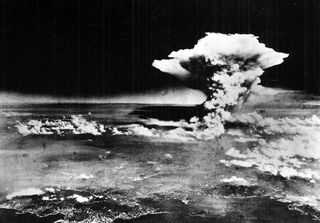 After the December 1941 attack on Pearl Harbor that killed more than 2,400 Americans, the United States entered World War II. Its Pacific campaign specifically targeted Japan — which fell nearly four years later, after the US dropped two nuclear atomic bombs on Hiroshima and Nagasaki, killing and injuring roughly 200,000 people. The massive blasts shocked Japan, and the rest of the world, with the weapons’ overwhelming destructive power.
After the December 1941 attack on Pearl Harbor that killed more than 2,400 Americans, the United States entered World War II. Its Pacific campaign specifically targeted Japan — which fell nearly four years later, after the US dropped two nuclear atomic bombs on Hiroshima and Nagasaki, killing and injuring roughly 200,000 people. The massive blasts shocked Japan, and the rest of the world, with the weapons’ overwhelming destructive power.
An aerial photograph of Hiroshima, Japan, shortly after the US dropped the “Little Boy” atomic bomb in August 1945.Universal History Archive/UIG via Getty imagesOne week after the second nuclear attack, Japan’s uncompromising leader and quasi-deity Emperor Hirohito, who had seen 3 million of his subjects die in the war, gave a speech that laid the foundation for Japan’s surrender to the Allied powers the following month — and changed the course of his nation’s history for decades to come.
In a five-minute radio address prerecorded on a phonograph and broadcast to the entire nation at noon local time on August 15, 1945, Hirohito informed the Japanese people that his government was accepting the Potsdam Declaration, which called for the unconditional surrender of all Japanese armed forces:
To our good and loyal subjects: After pondering deeply the general trends of the world and the actual conditions obtaining in our empire today, we have decided to effect a settlement of the present situation by resorting to an extraordinary measure.
We have ordered our Government to communicate to the Governments of the United States, Great Britain, China and the Soviet Union that our empire accepts the provisions of their joint declaration.
Those provisions included that the Japanese military disarm and that parts of the country be occupied by Allied forces “until there is convincing proof that Japan’s war-making power is destroyed.”
This inglorious surrender — and all the indignities that would come along with it — was necessary, Hirohito said, in order to save millions more Japanese who would inevitably be killed by additional nuclear bombs if the country continued fighting. Indeed, such a full and complete surrender was necessary in order to ensure the preservation of the Japanese nation itself.
Hirohito’s speech ended with a clarion call for his country members to strive for peace: “It is according to the dictates of time and fate that we have resolved to pave the way for a grand peace for all the generations to come by enduring the unendurable and suffering what is not sufferable,” he declared.
Thus ended Japan’s military empire, also leading to the dissolution of Japan’s colonial rule on the Korean Peninsula and its brazen efforts to conquer much of Asia.
Two years later, Japan adopted a new constitution — drafted over the span of just a week by a small team of Americans led by Gen. MacArthur, the supreme commander for the Allied powers — that reflected many of the sentiments expressed in Hirohito’s speech.
The very first sentence of the constitution’s preamble emphasized the Japanese people’s desire for “peaceful cooperation with all nations” and their resolve “that never again shall we be visited with the horrors of war through the action of government” — leaving no illusions about the kind of future the Allied powers envisioned for postwar Japan.
The new constitution featured remarkable changes, like downgrading the emperor’s authority and promoting human rights. But its most consequential and now controversial section, Article 9, detailed how Japan would renounce all war — forever:
Aspiring sincerely to an international peace based on justice and order, the Japanese people forever renounce war as a sovereign right of the nation and the threat or use of force as means of settling international disputes. In order to accomplish the aim of the preceding paragraph, land, sea, and air forces, as well as other war potential, will never be maintained. The right of belligerency of the state will not be recognized.
In effect, Japan transformed itself from one of the most aggressively militaristic nations in the world into a pacifist country with no ability to wage war.
And over the next several decades, pacifism became deeply entrenched in Japanese society as the country focused on rebuilding its economy. That attitudemainly persists today — but with some major caveats.
A pacifist nation becomes pro-military — but still antiwar
Japan’s constitution explicitly states that “land, sea, and air forces, as well as other war potential, will never be maintained.” And for a few years after the new constitution was adopted, the country abided by that to the letter, merely keeping a highly decentralized domestic police force and nothing else.
But in 1950, the Korean War broke out when North Korean leader Kim Il Sung sent his enormous ground forces into South Korea to take control of the entire peninsula. US troops who had been stationed in Japan as part of the postwar occupation were suddenly needed in South Korea. To make sure Japan could still defend itself once those US troops were redeployed and also to help in the Korean War, the US urged Japan to create a much more robust police force — one that looked less like the police and more like a lightly armed military.
That 75,000-strong force, called the National Police Reserve, eventually went on to become the Self-Defense Force (SDF), the quasi-military force that was officially established in 1954 and persists to this day.
Yet its existence was (and remains) highly contentious within Japan. After all, the country’s US-written constitution expressly prohibits the country from maintaining any armed forces. But the SDF isn’t a traditional military; its sole mission is to protect the Japanese people, mainland, and islands from external threats. It is expressly forbidden from attacking another country unprompted.
Which is why many Japanese governments over the decades have argued that the country doesn’t have a military — it merely has trained fighters who will protect the nation if necessary, but who don’t go around the world seeking enemies. In 1959, Japan’s supreme court backed this interpretation, ruling that the SDF didn’t violate the country’s constitution because the force is defensive in nature.
The Japanese public initially didn’t warm to its new protectors, though, and it didn’t help that popular films for decades showed it struggling against threats — including in Godzilla movies. There was also no real need to push for stronger armed forces. After all, Japan has a strong ally in the United States that vowed to protect it with conventional troops and even its nuclear arsenal if under attack. That security blanket let Japan care more about economics than security for decades, experts say.
Members of the Self-Defense Force arrive at the compound of the United Nations peacekeeping mission (UNMISS) after landing in Juba, South Sudan, on November 21, 2016.Albert Gonzalez/AFP/Getty ImagesBut two major turning points changed the public’s negative perceptions of the SDF. At the start of the 1991 Gulf War, Japanese Army Maj. Nozomu Yoshitomi was in the middle of a war game with US military officers when he noticed that the Americans were watching CNN’s coverage of the conflict on a nearby TV — while a second monitor showed images of Japanese forces making snowmen on the local news.
“They asked how Japan could be a true US ally if it hadn’t sent troops,” Yoshitomi told Reuters journalists Tim Kelly and Nobuhiro Kubo in 2015. And though Tokyo eventually sent $13 billion to help with the military effort to drive Saddam Hussein’s forces out of Kuwait, it didn’t send any troops — because its antiwar constitution forbade it.
That was a huge embarrassment for the Japanese military and the public writ large: Though its forces regularly engaged in military exercises with the US — exercises like that war game Yoshitomi described — when it came time to actually stand and fight alongside their close ally in a real war, Japan’s forces had to sit it out. “We learn[ed] from the Gulf War that just sending money and not people would not earn us international respect,” Tetsuya Nishimoto, a retired top SDF general, also told Reuters.
So Japan found a workaround: sending its troops to participate in United Nations and other peacekeeping missions abroad. In 1992, Japan sent peacekeepers as part of a UN delegation to Cambodia, the first time Japanese troops were deployed outside of the country since World War II. Since then, Tokyo has sent its troops around the world — to Africa, Southeast Asia, the Middle East, and beyond — to serve as buffers between warring factions.
It was a smart play: Sending peacekeepers into war zones allowed Japan to play an important role in armed conflict and partner with allies like the US, but without having to actually fight anyone. Seeing deployed Japanese forces helped rehabilitate the SDF’s image at home and abroad, experts say.
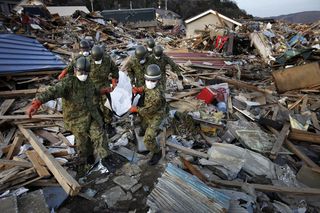 Self-Defense Forces carry a body recovered from under a crushed house on April 1, 2011, in Ishinomaki, Miyagi, Japan, after a massive earthquake and tsunami hit northern Japan two weeks earlier.Kuni Takahashi/Getty ImagesThe second turning point in the SDF’s evolution, though, was much more catastrophic and consequential. On March 11, 2011, a massive 9.0 earthquakestruck off the east coast of Japan — the largest tremor known in the country and one of the five largest ever recorded. Some eyewitnesses in Tokyo described seeing buildings swaying and feeling the ground move under their feet, while others recounted seeing people sleeping in transportation stations after the city’s trains and subways shut down, stranding millions.
Self-Defense Forces carry a body recovered from under a crushed house on April 1, 2011, in Ishinomaki, Miyagi, Japan, after a massive earthquake and tsunami hit northern Japan two weeks earlier.Kuni Takahashi/Getty ImagesThe second turning point in the SDF’s evolution, though, was much more catastrophic and consequential. On March 11, 2011, a massive 9.0 earthquakestruck off the east coast of Japan — the largest tremor known in the country and one of the five largest ever recorded. Some eyewitnesses in Tokyo described seeing buildings swaying and feeling the ground move under their feet, while others recounted seeing people sleeping in transportation stations after the city’s trains and subways shut down, stranding millions.
The reverberations were so strong they created a tsunami with 30-foot waves that began pounding the nation’s eastern seaboard less than an hour later. “[The wave] was mixed with mud, with ships and cars smashing toward wooden houses, dragging those into rice fields, and basically bashing them into pieces,” noted a Bloomberg report five hours after the earthquake hit.
The resulting floods brought down buildings and bridges and triggered a catastrophic meltdown at a nuclear energy plant. The devastation, in total, killed more than 22,000 people.
The SDF was called to rescue those in need and to help rebuild the country’s northeast. Around 100,000 of the then-240,000-strong force sprang into action. SDF forces dug people out of rubble and waded into rushing water to save those in danger of drowning. When troops found a victim they couldn’t rescue, they marked the site with a red flag. SDF forces also labored alongside local government officials to rebuild roads and worked around the clock to contain the nuclear disaster.
It was the first time in the postwar period that Japan had activated its reserves and deployed so many troops on the mainland — and it had a major impact. The SDF’s efforts won it high praise and plaudits from most of Japanese society. A Pew Research Center poll released that June found that 95 percent of the population thought the SDF had done a good job, with 62 percent saying it had done a “very” good job. “Without them, I don’t know what would have become of us,” one affected citizen told the Guardian two months after the earthquake.
Since then, the SDF has remained tremendously popular. A January 2018 Yahoo News poll found that about 90 percent of Japanese people had a positive impression of the forces. However, surveys continue to find that the public doesn’t support using those forces to fight in foreign battles.
“The Japanese military is the most respected institution in Japan,” Michael Green, a Japan expert at the Center for Strategic and International Studies in Washington, told me. “Japanese society isn’t anti-military anymore, but it is still antiwar.”
That change in sentiment could allow a leader who desires a more traditional military in Japan to push for change. Enter Shinzo Abe.
Abe has a global vision for Japan
Abe became Japan’s prime minister for a second time in 2012, restoring his conservative Liberal Democratic Party’s decades-long rule after a three-year hiatus. An avowed nationalist, he came into office making two big promises.
The first was to jump-start Japan’s sputtering economy — and his record on that so far is mixed. Japan’s economy hasn’t skyrocketed under his leadership, but it has grown modestly despite recent contractions. And Abe has made some pretty remarkable reforms, such as allowing foreign workers into the country for five-year periods and making it easier — although it’s still far from easy — for women to work outside the home by expanding kindergarten and home care.
Japanese Prime Minister Shinzo Abe attends an event held before his party’s annual convention on February 10, 2019, in Tokyo.Tomohiro Ohsumi/Getty ImagesBut his second promise was more visible to the world: Japan would pursue a muscular foreign policy with a special focus on countering China.
“I’ve realized that Japan is expected to exert leadership not just on the economic front, but also in the field of security in the Asia-Pacific,” he told the Wall Street Journal in October 2013, just 10 months after taking office. “There are concerns that China is attempting to change the status quo by force, rather than by rule of law,” he continued, adding that “it shouldn’t take that path, and many nations expect Japan to strongly express that view.”
Abe administration officials I spoke with say the current worry isn’t that a Chinese attack on Japan is imminent. Rather, the concern is that Beijing’s growing economic and military prowess could allow it to reshape the world in its image. Abe, however, likes the current system and argues the only way to preserve it is to push back when required.
In effect, the current China-Japan fight is really about competing visions of the future — and Japan is struggling to win. That’s in part because “no one expected” China to have the military might it has today, according to one top Japanese defense official I spoke with. What’s more, few expected Japan’s neighbor to so brazenly challenge Japan’s sovereignty in regional waters.
If Abe is successful, he may change the course of Japanese history
The Japanese official explicitly pointed to the problem of the Senkaku Islands. The islands, a few rocks in the East China Sea about halfway between the Chinese and Japanese mainlands, are claimed by both Beijing and Tokyo. Since 2012, China has sent some of its most advanced warplanes and ships to patrol the areas around them.
About twice a month, China conducts what the official called “checkbox incursions”: Beijing’s ships come close to the islands, stay about an hour, and then leave. It happens like clockwork. On February 12, for example, China sent four of its ships to sail around the islands for roughly two hours.
And it doesn’t help that China has started to create its own islands in the South China Sea. Satellite imagery clearly shows that Beijing is turning some of the new land into military bases, going so far as to pave runways, base weapons and artillery on them, and place radars, among other things, on some of them. It’s the clearest indication yet that China aims to militarize the waters; Japan wants to patrol and control most of it.
And China may soon have more resources to throw its weight around. “China makes aircraft and ships like they make sausages,” the official continued, noting that the country will have even greater abilities to incur into areas Japan claims for itself. The US worries about that, too: A congressional report released in November 2018 predicted China’s military power may match America’s by 2050.
Add these concerns to others about a more aggressive Russia and a growing nuclear arsenal in North Korea and it’s no surprise that Abe has outlined a more global and forceful vision for Japan.
Aboard the Izumo, Capt. Toshiyaki Hirata, one of the ship’s deputies, briefed me and other reporters about it in the vessel’s central, spartan conference room. The moment had a classroom feel to it: The sailor stood at the podium, his posture rigid, and read from prepared talking points and went over a slick PowerPoint presentation as we took diligent notes.
His presentation boiled down to this: Japan wants a “free and open Indo-Pacific,”meaning any country can freely navigate from Asia to Africa for economic and military purposes. It’s a thinly veiled challenge to China’s own “Belt and Road Initiative,” where Beijing hopes to be the main economic — and perhaps military — partner for countries in Eurasia, the Middle East, and Africa.
That grand strategy makes Japan a vital partner for the United States, which works closely with other nations to keep those sea lanes open, as nearly half of the world’s oil passes through those waters. Japan’s willingness to patrol those thousands of miles — and its professionalism in doing so — has won Tokyo America’s respect.
“Japan is the bedrock of our security relationships, not only in northeast Asia but across the whole of the Indo-Pacific,” Adm. Philip Davidson, commander of US Indo-Pacific Command, told me. “They’re a highly capable maritime and defense force. I’m grateful that they’re an ally.”
Becoming a major player in the region may seem like the upper limit for Japan’s forces that legally can only defend the country. But it’s still not enough for Abe, experts say. “He really wants Japan to break away from some of its postwar reluctance,” says Smith, who wrote a book on Japan’s more active foreign policy.
And if Abe is successful, he may change the course of Japanese history.
Japan’s “more active” military, in three steps
How has Abe tried to realize his vision? With a mixture of political and military reforms that slowly but surely add up to a more global, active Japanese foreign policy. Three moves in particular stand out.
1. “Collective self-defense”
Throughout 2014 and 2015, Abe pushed to amend the nation’s laws. He formed a committee to propose some changes, and one of the first they considered was to allow the SDF to participate in “collective self-defense.”
Since the mid-1950s, Japan could only strike back at those who attacked it. It couldn’t retaliate if an adversary shot down, say, an American ship with Japanese citizens or troops on it — but that’s what Abe’s administration wanted to do.
The proposal was highly controversial. The Diet, Japan’s parliament, debated the measure for around 200 hours, even though Abe’s party controlled the lower chamber. It also sparked some of the largest protests in Japan’s history as tens of thousands around the country rebelled against the rule change.
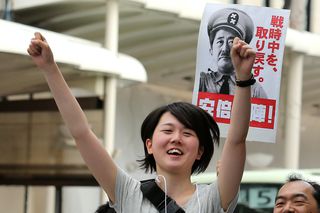 Critics’ core argument against the new law was that it would give Japanese forces a pathway to war against other countries. Some critics even called the law change “war legislation” and depicted Abe as Germany’s Adolf Hitler.
Critics’ core argument against the new law was that it would give Japanese forces a pathway to war against other countries. Some critics even called the law change “war legislation” and depicted Abe as Germany’s Adolf Hitler.
A Japanese university student shouts slogans against the collective self-defense plan on June 21, 2015, in Kyoto.Buddhika Weerasinghe/Getty ImagesAbe tried to quell those concerns. “There is a misunderstanding that Japan will become caught up in wars in order to defend foreign countries,” he said during a July 2014 press conference. “In fact, such a case is also entirely out of the question.”
He continued: “The measures that the Constitution of Japan permits are only self-defense measures for the purpose of ensuring Japan’s survival and protecting its people … [T]aking all possible preparations will serve as a great deal of power that will thwart schemes to wage war on Japan. This is what we call deterrence.”
It was textbook Abe. He advocated a major change — allowing Japan to strike back if an ally is attacked — while reassuring that the move wouldn’t draw his country into a larger battle. It’s indicative of the tightrope he’s walked when pushing new, aggressive measures: making sure the public, China, North Korea, and others know Japan isn’t looking for trouble but just beefing up its own defenses. The legislation eventually passed and came into force in March 2016.
I asked a top Japanese diplomat about the new law and the real rationale for it. He admitted that it was drafted with North Korea in mind. Pyongyang’s missile arsenal is capable of striking Japanese ships and cities with conventional and nuclear weapons. In the event of a US-North Korea war, for example, the old law meant Japan couldn’t help its American ally if the US was attacked. Legally, it would have to stand idly by as a major war raged. Passing the new law now would let Tokyo better help Washington deter an aggressive move by Pyongyang.
The official said he was glad the legislation passed three years ago, but that it’s still extremely hard for Abe’s administration to safeguard the country against all threats with such pacifist citizens and lawmakers. That hasn’t stopped Abe from planning for a more robust Japanese defense, though.
2. Increased defense spending
In December 2018, Japan released its 10-year defense plan — and it highlights just how significantly Abe wants to change his country’s direction.
The plan calls for converting the Izumo into an aircraft carrier, giving the nation its first vessel of that kind since World War II; spending about $240 billion on the SDF over the next five years, continuing the nation’s slow but steady increase in defense expenditures; and purchasing new fighter jets to replace old ones.
Those are big steps for Japan to take, as it’s hard to argue it really needs all that equipment to safeguard the mainland. But what the document makes clear is that Abe is worried about the rapidly changing security situation around his country.
Japanese Prime Minister Shinzo Abe reviews Self-Defense Force soldiers at the SDF training ground in Asaka, Saitama prefecture, on October 14, 2018.Kazuhiro Nogi/AFP/Getty ImagesThree main trends likely worry him the most. First, President Donald Trump promotes a less engaged America. That’s led experts and officials I spoke to in Japan to wonder about the long-term health of the US-Japan alliance and may partly animate Tokyo’s desire to ensure it can take care of itself in the event the US doesn’t come to its defense.
Second, Japan is unhappy about North Korea’s ability to attack Japan. Pyongyang hasn’t tested a missile or nuke since 2017, mainly because it doesn’t want to end diplomatic talks with the US and keep Trump happy. Still, Japan wants to ensure it can defend against an improving arsenal pointing its way.
Third, and most importantly, China looms largest in the minds of Japanese officials as the long-term threat. That’s mostly due to its efforts to claim territory in disputed waters, its economic prowess, and military largesse. Having new and upgraded weaponry will help defend against and deter a possible attack. But with an eye to the future, it may also allow Japan to ably protect itself should a war with Beijing break out.
Japanese officials balk at any suggestion that the country would ever get into a shooting war with China. “China has been our neighbor for thousands of years, and it’s going to be for thousands more,” the top diplomat said, reassuring me that Tokyo has no designs to use force against its regional foe despite Japan’s “more and more active” military.
A top Japanese defense official made the same point in starker terms: “We can’t provoke China. That would be suicide for us.”
But convincing China of Japan’s harmless intentions is proving to be a bit harder. “Such [a] move by the Japanese side is not conducive to the improvement and development of China-Japan ties or the peace and stability in the region,” Hua Chunying, a spokesperson for China’s foreign ministry, said at a news conference in December.
“We urge Japan to keep its commitment to the ‘purely defensive defense’ strategy, stay committed to the path of peaceful development and act cautiously in the area of military security,” she continued.
It again highlights the problem Japan has breaking out of its postwar hangover without angering China. Should Tokyo develop too slowly, it could fall further behind Beijing in military strength. But if it arms too quickly, China and other adversaries may miscalculate and believe it’s laying the foundations for war.
That, of course, would be the worst outcome. A war between China and Japan would almost certainly be the catalyst for a third world war, some experts say. Luckily, Beijing doesn’t seem overly worried about Japan’s moves right now. “China is biting its lip because it knows it can defeat Japan” in a fight, Green, who led the Japan portfolio in George W. Bush’s National Security Council, told me.
That may be why, last October, Chinese President Xi Jinping agreed to meet Abe, the first bilateral meeting between the two countries in more than seven years. Neither leader is happy with the other, partly over the islands dispute, but opening a dialogue could help both sides curb the rising tensions.
Beijing may yet be waiting to see if Japan makes its biggest move yet — actually amending its antiwar constitution for the first time.
3. Changing the constitution
Last September, Abe was reelected as the head of his Liberal Democrat Party (LDP). His prime ministership is therefore safe for now, but it’s possible he could face a massive rebuke during elections this summer, as experts say Abe’s party may not hold on to the Diet’s upper house. On April 21, Abe’s ruling party lost in two by-elections, signaling a dip in support.
Which means Abe now has his eyes on some grander ambitions as his power wanes: his place in Japan’s pantheon. “Abe has been at the top of the nation for so long now, and I think that if there is one possible way he could earn his place in history, it’s revising the constitution,” Yoshiaki Kobayashi, a political science professor at Keio University, told the Japan Times on January 2.
It’s something Abe’s party has wanted to do since at least 2012, and the proposed changes have wide-ranging implications — especially regarding Article 9.
Members of the Japan Ground Self-Defense Force take part in a live-fire exercise at the foot of Mount Fuji on August 23, 2018, in Gotemba, Shizuoka, Japan.Tomohiro Ohsumi/Getty ImagesThe potential new constitution still renounces war or any hostilities, but it does say Japan can have a “National Defense Force” (NDF). The prime minister would lead those troops — just like the US president does as commander in chief — and they could work toward “peace and [the] security of international society.”
That’d be a massive shift. Not only would the 1947 constitution change, but also it would codify armed forces in Japan for the first time. What’s more, the NDF would legally be allowed to work with other countries to patrol sea lanes and keep the peace abroad, not just safeguard the homeland.
If passed, it would permit Japan to have a traditional military once more. But it’s unclear if Abe will get his wish.
Politics and Japanese public opinion could thwart Abe’s Article 9 dream
Only 29 percent of the Japanese public last year said they wanted to see a revised constitution; 27 percent said they didn’t, and the rest were unsure how to answer. Japan, then, is both deeply divided and perhaps somewhat ambivalent about Abe’s legacy-defining initiative.
It doesn’t help that Abe’s party shares power with another one, Komeito, to stay in charge. Komeito’s base is largely pacifist, forcing politicians in that party to walk a fine line when discussing possible constitutional changes.
Shinichi Isa is one of them, and the three-term Osaka representative looks the part. When we met in his Diet office, his jet-black hair was neatly parted on the right side and his confident demeanor exuded an elder statesman’s aura despite his middle age.
That confidence wavered a bit as our conversation turned to changing the nation’s laws. “We are very open to discuss the amendment of the constitution,” he told me and other reporters. “But we need to carefully think about the timing.” He noted that to make the changes, two-thirds of the lawmakers in the upper and lower houses must approve it. After that, the majority of the Japanese public must vote for the amendments in a referendum.
As of now, that last part seems all but impossible. “Yes, we can pass the measure in both Houses” if another party joins the effort, but the referendum is still “full of risks,” mainly the proposal’s unpopularity.
“We can’t provoke China. That would be suicide for us.”
It’s not just the mechanics that bother Isa; it’s also what the LDP, Abe’s party, has proposed. “What are the limitations?” he asked rhetorically, nodding to the national worry that deferring so much to Japan’s armed forces could lead to a future war. He still made sure to note that “of course” Tokyo should have the right to participate in collective self-defense, especially if the United States is attacked.
Komeito’s ambivalence, then, remains a major hurdle for Abe’s ambitions. But, as Isa points out, it’s the public that could ultimately thwart them.
A woman casts her vote for parliament’s lower house election at a polling station on October 22, 2017, in Himeji, Japan.Buddhika Weerasinghe/Getty ImagesTo get a small sense of their sentiment, I wanted to speak with regular people outside of Tokyo. So it seemed fitting to have a conversation about Japan’s future in its ancient capital. Kyoto, about a three-hour bullet train ride westward from Tokyo, is a physical treasure where Japan’s centuries of history mingle with the modern. It was here that I planned to meet Masahiro Yamaguchi, an old friend with whom I’ve stayed in touch for years after he lived with my family during a high school exchange program.
Now a human resources manager, he first met me while I was just entering middle school. Little did we both know the next time we’d see each other — nearly two decades later — would be to discuss Japan’s military trajectory over sushi and sake.
We sat in the private back room of a modest restaurant in the city’s old quarter. His friend Ayano Kohsei, a massage therapist who also participated in the exchange program, joined us for the conversation. They have been friends for years, but they still disagree on Japan’s military future.
“We need more power and a strong Self-Defense Force,” Masahiro said, “but Japan should not have a military.” He likes what the SDF already provides: protection of the islands and mainland, and a deterrent against foreign invasion. Japan can improve those defenses, sure, but it shouldn’t go further than that. “We can’t ever attack another nation.”
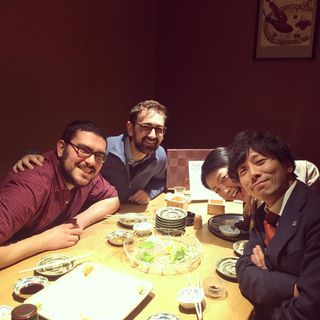 That’s not how Ayano sees it. “I disagree with the Self-Defense Forces because it’s already a kind of army,” she told me. “People who want peace shouldn’t have any forces, even for self-defense.” If she were in charge, Japan would abolish all military-like institutions and hope that the decision would turn the country into the world’s pacifist beacon.
That’s not how Ayano sees it. “I disagree with the Self-Defense Forces because it’s already a kind of army,” she told me. “People who want peace shouldn’t have any forces, even for self-defense.” If she were in charge, Japan would abolish all military-like institutions and hope that the decision would turn the country into the world’s pacifist beacon.
But her view also comes from a broader ideological stance: “I don’t think anyone in this world should have armies of self-defense forces.”
Me, Foreign Policy’s diplomacy and national security reporter Robbie Gramer, Ayano Kohsei, and Masahiro Yamaguchi talking Japan’s military over food and drinks.Alex Ward/VoxAnd then the fireworks began. “China, North Korea, or even Russia may attack Japan,” Masahiro said, turning to Ayano. “We have to defend our country.” Ayano, though, stood her ground and revealed her main concern: “I simply don’t want Japanese people to die, and I don’t want Japanese people to kill other people.” On that last point, at least, they could both agree.
Of course, this was only a conversation with two young Japanese people, with somewhat similar backgrounds, in a metropolitan area of the country. But Masahiro and Ayano’s views are still indicative of a major strain of thought when it comes to the constitutional amendment question, namely that Japan should stand for peace. Any movement toward a more traditional military increases the chance of war on the island, they fear, and that Japanese forces will ride with the US into a foreign fight.
Should the Diet try to reform Article 9, people like Masahiro and Ayano will vote in the nationwide referendum — and Abe must fear their participation.
Japan’s tightrope should matter to all of us
Japan under Abe senses it’s in danger. It’s surrounded by an imminent threat, North Korea. It has a long-term challenger, China. And its top ally, the United States, seems to be retreating from its postwar leadership role in the world.
So Abe’s desire for stronger, unrestricted, more capable forces doesn’t come from nowhere. There are legitimate reasons for Japan to, well, provide for its self-defense the best way it can. But aware of its history and how others in the region view it, Japan has to mask its efforts to improve its forces.
“I simply don’t want Japanese people to die, and I don’t want Japanese people to kill other people”
A conversation I and other reporters had with Keitaro Ohno, a top defense lawmaker in Abe’s party, made that very clear. He let slip that Abe had approved the new muscular defense guidance and the purchase of 147 US-made fighter jetsbefore they were officially announced. The goal, Ohno said, was to replace the same number of older fighter jets with the more modern planes.
In other words, Japan isn’t adding new, better planes; it’s just replacing old ones. But it’s a difference without a distinction.
Just because the total number of Japanese warplanes stays constant doesn’t mean other countries won’t care. Self-Defense Forces can do much more with new aircraft, like take off vertically, than they can with the older model, and gain superiority over Chinese planes — even if they may still have some major problems. Still, Ohno can’t outwardly admit Japan is gearing up to have more traditional forces — even if it’s an open secret.
But Ohno is not alone. What he and countless other Japanese officials evinced in our conversations were iterations of the same thing. Of course Japan is improving its defenses, they said, but other countries shouldn’t worry. And no, Tokyo will never go to war, they assured me. Don’t be ridiculous.
It happened on the Izumo. Those planes, which will soon dot the ship’s surface, produced a problem for Capt. Motoyama, the vessel’s top sailor. He had to know American reporters interviewing him that cold morning would ask about the expected acquisition of F-35 jets.
When asked if the Izumo could carry aircraft, he replied, with a hint of a smile: “Yes, helicopters.”
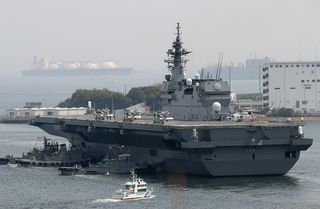
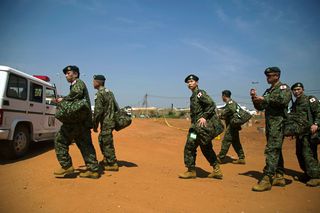
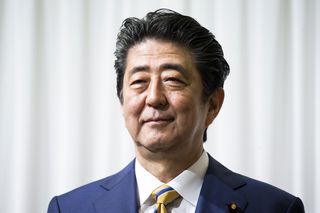


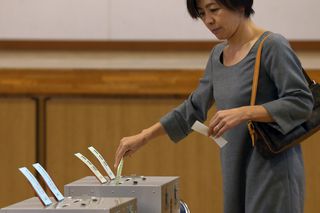
No comments:
Post a Comment